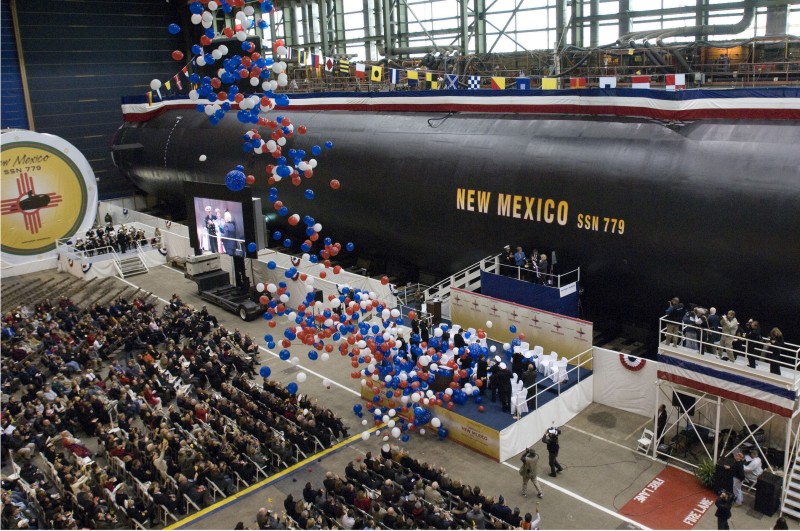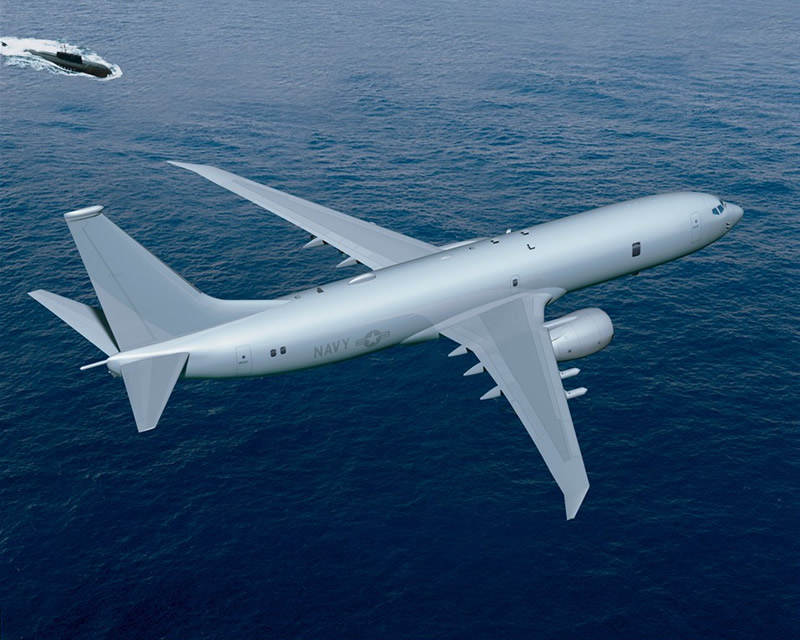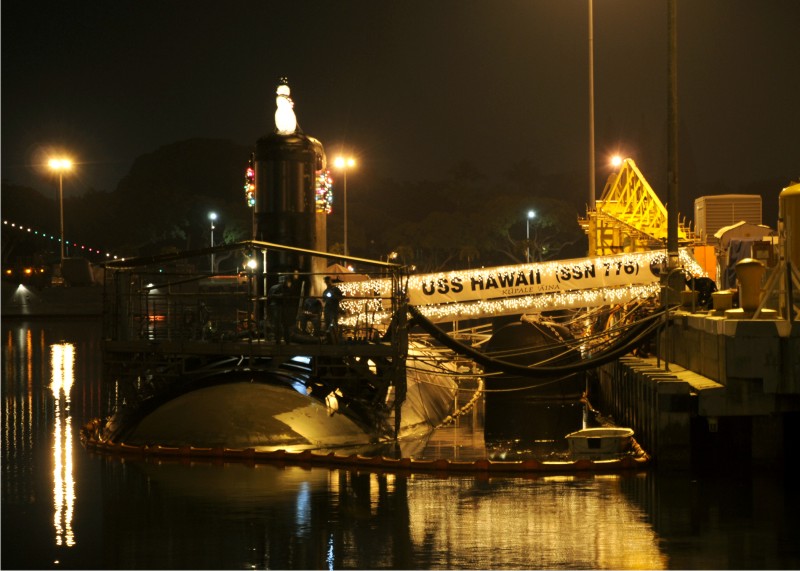
Welcome to MSW’s Scuttlebutt! Here’s the news for the day.

Northrop Grumman-Built Submarine New Mexico (SSN 779) Returns from Successful Sea Trials
Source: Northrop Grumman Corp.
NEWPORT NEWS, Va. --- New Mexico (SSN 779), the nation's newest and most advanced nuclear-powered submarine, returned to Northrop Grumman Corporation's Shipbuilding sector in Newport News, Va. after completing the ship's first round of successful sea trials on Nov. 26.
Sea trials provide an opportunity to test all systems, components and compartments and include submerging for the first time, high-speed runs while on the surface and submerged, and a demonstration of the submarine's other capabilities.

"The first sea trial is a milestone that the entire shipbuilding and Navy team has been working hard to achieve," said Becky Stewart, vice president for Northrop Grumman Shipbuilding's submarine program. "This accomplishment is a testament to the craftsmanship, dedication, persistence, and pride that our people take in the product they build -- a very complex and high quality submarine."
New Mexico is the sixth ship of the Virginia class and is in the final stages of construction and testing at the company's Newport News shipyard. Delivery to the Navy is scheduled by the end of this year. The keel for New Mexico was authenticated April 12, 2008. The ship was christened on Dec. 13, 2008.
New Mexico is named for "The Land of Enchantment." Upon delivery to the Navy this year, it will be the most modern and sophisticated attack submarine in the world, providing undersea supremacy well into the 21st century.
Northrop Grumman Newport News is teamed with General Dynamics Electric Boat to build the first 18 ships of the Virginia class. Current plans call for 30 Virginia-class submarines in the fleet. Using millions of parts from over 4,000 suppliers in 47 states and the District of Columbia, Virginia-class submarines incorporate dozens of new technologies and innovations and are the first major combatants designed with the post-Cold War security environment in mind.
Navy Announces Contract Award Values for Littoral Combat Ships 3 and 4
Source: US Navy
WASHINGTON --- As a result of the Navy's change in acquisition strategy for the Fiscal Year (FY) 2010 Littoral Combat Ship (LCS) program, the Navy can now release the pricing for LCS 3 and LCS 4 awarded contracts.
The total value of the LCS 3 contract, awarded to Lockheed Martin Corporation on March 23, was $470,854,144 which includes ship construction, non-recurring construction and additional engineering effort, configuration management services, additional crew and shore support, special studies and post delivery support.
The total value of the LCS 4 contract, awarded to General Dynamics - Bath Iron Works on May 1, was $433,686,769 which includes ship construction, non-recurring construction and additional engineering effort, configuration management services, additional crew and shore support, special studies and post delivery support.
The contract values do not include government costs which include government furnished equipment, change orders, and program management support costs. The contract values do not include the cost of continuation work and material used from the terminated original contract options for LCS 3 and 4. The value of the continuation work and material from the terminated LCS 3 was $78 million for Lockheed Martin Corporation and $114 million from the terminated LCS 4 for General Dynamics/Bath Iron Works.
The dollar value of the fixed-price-type contracts awarded to each LCS prime contractor to procure two LCS seaframes in FY 2009 was previously considered source-selection sensitive information because the price of the FY 2009 ships was to be linked to the competitive solicitation for the FY 2010 ships. That solicitation was cancelled and a new acquisition strategy does not link the FY 2009 prices with the FYs 2010-2014 source selection, thereby allowing normal release of this contract data.
The Navy remains committed to the LCS program and the requirement for 55 of these ships to provide combatant commanders with the capability to defeat anti-access threats in the littorals, including fast surface craft, quiet submarines and various types of mines. The Navy's acquisition strategy will be guided by cost and performance of the respective designs as well as options for sustaining competition throughout the life of the program.
HMS Dauntless is Delivered
Source: UK Ministry of Defence
HMS Dauntless - the second of six new formidable air defence warships - was handed over to the Ministry Of Defence at a ceremony in Portsmouth today.
HMS Dauntless was launched from BAE Systems’ Govan shipyard in Glasgow on 23 January 2007. After extensive sea trials she made her first entry into her home port of Portsmouth yesterday (2 December). She follows HMS Daring – the Royal Navy’s first Type 45 destroyer – which arrived in Portsmouth in January this year.
BAE Systems, builders of the new fleet of Type 45 destroyers, handed over HMS Dauntless today to the Royal Navy’s Deputy Commander-In-Chief Fleet, Vice Admiral Richard Ibbotson.
During a ceremony on the ship’s flight deck at Portsmouth Naval Base, the BAE company flag was lowered and replaced by the Royal Navy’s White Ensign.
The Minister for Defence Equipment and Support, Quentin Davies, said:
“The six Type 45s will be the largest and most powerful destroyers ever operated by the Royal Navy. With the second of class now in the hands of the MoD, we are forging ahead to deliver an unparalleled air defence capability to the Royal Navy.
“HMS Dauntless has gone through several stages of sea trials in which she has truly impressed the ship’s company. She will now embark on a final set of trials that will really put her to the test before she is commissioned into the Navy in the summer of 2010.”
Vice Admiral Richard Ibbotson, the Royal Navy’s Deputy Commander-In-Chief Fleet, said:
“The Royal Navy is looking forward to Her Majesty’s Ship Dauntless taking her place in the Fleet with much anticipation and congratulates everyone involved in delivering her this far. HMS Dauntless and her sister ships are world beaters and the people of the Royal Navy are second to none. This is a winning combination, and the ship provides us with the tools to do the job, whatever the country requires of us, for years to come. It is therefore with great excitement that we welcome the cutting edge capability that the new T45 displays.
“With the ability to integrate both land and air forces, HMS Dauntless truly is a joint asset and will carry out a wide range of operations, whilst remaining a highly effective air defence ship. Dauntless is a magnificent feat of engineering.”
Angus Holt, UK Programmes Director at BAE Systems’ Surface Ships business, said:
“Today is the culmination of hard work, commitment and a fantastic partnership between BAE Systems, the Royal Navy and our suppliers to produce one of the finest ships in the world.
“Everyone involved in creating this ship should be extremely proud of their achievements. HMS Dauntless truly is a magnificent ship and I am delighted on behalf to hand over to the Royal Navy on behalf of BAE Systems today.”
The prime role of the Type 45 destroyer will be air defence – protecting UK national and allied and coalition forces against enemy aircraft and missiles. The technology onboard the Type 45 will set new standards in air defence, capable of defending the Type 45 and ships in its company from multiple attacks from even the most sophisticated anti-ship missiles and aircraft.
Sister ships HMS Diamond, Dragon, Defender and Duncan are at various stages of build and will all enter service progressively through to the middle of the next decade. All will be based in Portsmouth.

First Navy Test Pilot Flies P-8A Poseidon
Source: US Naval Air Systems Command
NAVAIR PATUXENT RIVER, MD --- When a new Navy aircraft takes to the skies it is always a proud moment for any aircraft program. For the actual pilot behind the controls, it is an even greater feeling.
Lt. Roger Stanton had the privilege of being the first Navy test pilot to fly the P-8A Poseidon in October.

“It felt awesome,” Stanton said. “The first time you fly a new airplane it’s just a great experience. This is what test pilots are trained to do, so getting this rare opportunity was really amazing.”
Stanton, along with Boeing pilot Doug Benjamin, flew the first Poseidon, designated T1, over the Puget Sound in Washington, kicking off the formal Navy flight test program.
“It was a good day - a really good day,” Stanton said. “All the training I received was great. We rehearsed the flight profile many times so we came into the flight very well prepared, but it was still fun.”
Stanton began T1 flight preparation in 2008 with Boeing 737 training in Seattle, consisting of classroom courses, computer-based training and a mixture of commercial 737 simulators as well as time in an actual 737 aircraft. He also spent approximately 250 hours in the Weapon System Integration Lab, located in Kent, Wash.
The WSIL is a non-motion based simulator designed to help the test team integrate aircraft and mission systems, as well as, test aircraft components.
“For the baseline P-8, it certainly flies like a 737,” he said. “They did a nice job of building the airplane. The interesting flying for the P-8 really will come when we have to emulate the P-3 mission – high bank angle, low altitude, autopilot integrated into our mission with missiles on the wings. It will get interesting.”
That type of flying will come later in the test program. T1 actually made three flights in October, prior to undergoing more instrumentation installation in the factory. The first flight was to check the airworthiness, or how well the modified 737 aircraft flies with all the test instrumentation.
The second two flights practiced instrument approaches with a visual restrictive device. Stanton said one of the things the Navy closely monitors is whether or not the pilots are capable of safely flying the plane if they can’t look out the window for visual reference.
Initial testing of T1 is being conducted in Seattle. It will transfer to Pax in early 2010, where flight and operational testing will be completed by the integrated test team (ITT).
The Poseidon ITT, comprised of Navy test squadrons -- Air Test and Evaluation Squadron 20 and Air Test and Evaluation Squadron 1 -- and Boeing, will spend the next 36 months flying and evaluating three aircraft, designated T1, T2 and T3. The evaluation will include extensive mission systems testing, operational effectiveness and ability to carry out the anti-submarine warfare, anti-surface warfare and intelligence, surveillance and reconnaissance operations in accordance with Naval Air Systems Command requirements.
Stanton said the maritime patrol and reconnaissance community needs a new aircraft and needs it badly. He said the Fleet needs an airframe that’s capable of meeting the requirements set forth by the Navy and that support the maritime strategy.
“Our job here is to test that capability on the Poseidon,” he said. “As an operational P-3 pilot, I am fully aware of the challenges facing the [MPRA] community as they try and execute their high demand mission with a dwindling number of aging assets. Testing the P-8 and getting it to the [MPRA] community as soon as possible will help alleviate some of those challenges.”

USS Grayling (SS-209)
Today’s website is USS Grayling (SS-209).
This Day in U.S. Naval History
1861 - Congress declares Naval personnel eligible for the Medal of Honor, the Nation's highest award.
1943 - USS Grayling (SS 208) sinks its fourth Japanese ship in three days.
1951 - The first helicopter landing aboard a hospital ship takes place aboard USS Consolation (AH 15).
1968 - Apollo 8 is launched with Capt. James A. Lovell Jr. as Command Module Pilot. During the mission, Lovell becomes one of the first three people to see the far side of the moon. The mission lasted 6 days and 3 hours, including 10 moon orbits. Helicopters from USS Yorktown (CVS 10) take care of the recovery.
Photo of the Day

The crew of the Virginia-class fast attack submarine USS Hawaii (SSN 776) demonstrate their holiday spirit with Christmas lights at Naval Station Pearl Harbor.
Gator











